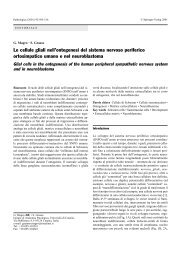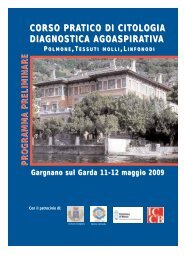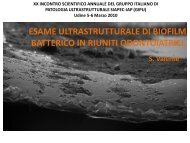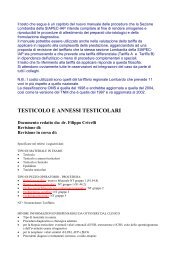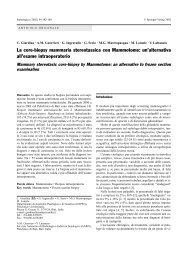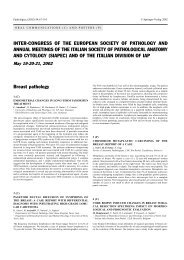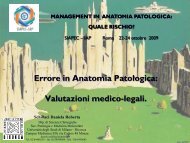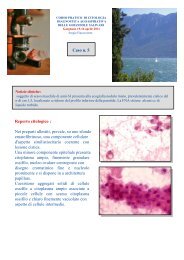Create successful ePaper yourself
Turn your PDF publications into a flip-book with our unique Google optimized e-Paper software.
PATOLOGIA MOLECOLARE<br />
Fig. 1.<br />
The correct and early diagnosis of pancreatic cancers is another<br />
important challenge that is encountered with this type<br />
of tumor, also because its typical symptoms (abdominal pain,<br />
unexpected weight loss, jaundice) are rather unspecific and<br />
can point to a variety of different GI tract problems, with<br />
chronic pancreatitis, that is a persistent inflammatory disease,<br />
being the clinically most relevant differential diagnosis<br />
for pancreatic cancer. In fact, in the course of chronic pancreatitis<br />
inflammatory tumors may develop in the pancreas<br />
causing the same signs and symptoms as malignant pancreatic<br />
tumors. Malignant and inflammatory tumors are frequently<br />
indistinguishable by conventional imaging modalities such<br />
as computed tomography (CT), abdominal (US) or endoscopic<br />
ultrasound (EUS), thus requiring cytological analysis<br />
of cells obtained by US-, CT- or EUS-guided fine needle aspiration<br />
biopsy (FNAB). However, the reliability of the<br />
largely morphology-based cytological analyses of fine needle<br />
aspirates of pancreatic tumors remains unsatisfactory with a<br />
diagnostic accuracy between 60% and 80% 11-15 . Well-differentiated<br />
carcinomas may escape recognition because of the<br />
minimal cytological atypia they display. Conversely, chronic<br />
pancreatitis may give rise to atypical cells that can be mistaken<br />
for neoplastic cells. For both, malignant and benign tumors,<br />
diagnosis is extremely difficult when intact cells in the<br />
aspirate are rare or completely missing.<br />
DNA arrays with their potential to assess the transcriptional<br />
activity of many genes simultaneously are ideal tools for diagnostic<br />
approach relying on the analysis of multiple genetic<br />
markers rather than morphological evaluation of biopsy material.<br />
In collaboration with Prof. Thomas M. Gress (University of<br />
Ulm, Germany) we have tried to develop a specialized cDNA<br />
array designed for the differential diagnosis of pancreatic tumors<br />
based on expression profiling of fine needle aspiration<br />
biopsies.<br />
Diagnostic array was constructed to only contain genes with<br />
diagnostic and/or prognostic potential for the classification<br />
of pancreatic tissues, augmented with control features to<br />
allow for precise grid alignment and robust normalization. In<br />
the present study, we used residual material from biopsy<br />
needles for the analysis of the FNAB samples to ensure<br />
complete identity of the material used for cytological and<br />
243<br />
expression profiling analysis. As a result, the amount of<br />
starting material available for expression profiling analysis<br />
was extremely limited, so that we initially produced the array<br />
in the nylon membrane format to take advantage of the<br />
superior sensitivity of radioactive labeling and detection.<br />
Instead of omitting individual genes from the analysis to<br />
achieve this purpose, we opted to apply principal component<br />
analysis to the data, resulting in a set of combined features<br />
representing weighted combinations of all genes in the data set.<br />
This approach is far less sensitive to outliers or hybridization<br />
artifacts in individual diagnostic samples, thus increasing the<br />
reliability of the analysis. Robustness of classification was also<br />
the rationale for choosing linear discriminant analysis (LDA)<br />
for the construction of the classifier.<br />
We were able to demonstrate that expression profiling analysis<br />
using our specialized diagnostic array in conjunction with<br />
conventional cytology significantly improves the accuracy of<br />
diagnosis and is especially useful in the classification of<br />
otherwise ‘non-diagnostic’ samples, i.e. samples with low<br />
cellularity or complete absence of intact cells.<br />
Fig. 2.





